Anatomy, physiology and Pink Floyd: memories of the Class of 1972
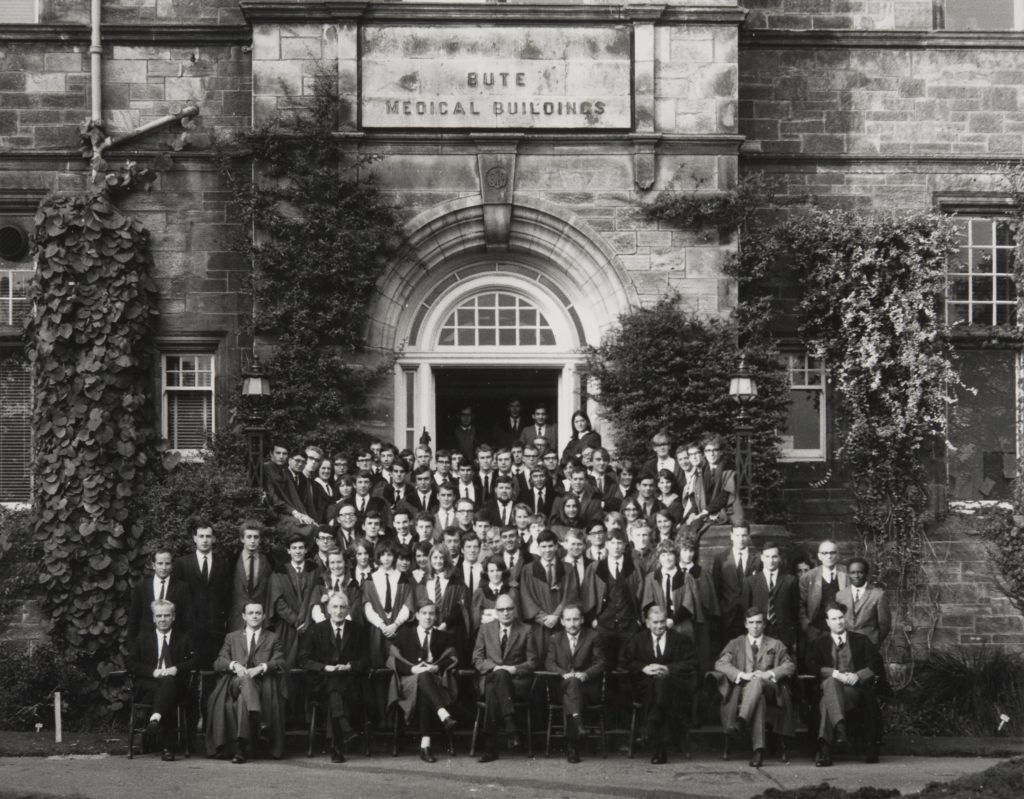
Memories
It was October 1966 when we first matriculated – forty of us for the MB ChB course in St Andrews and another forty in Queen’s College in Dundee. We had parallel courses throughout our first year, (Physics, Chemistry, Zoology and Botany) and throughout second and third year too (Anatomy, Physiology, and in second year, Biochemistry).
According to tradition, we had our pre-sessional weekend including a pier walk and drinking to excess in the Union (advised by the Master, who recommended finding our capacity and not exceeding it thereafter). We wore our red gowns at dinner on weekdays and selected our senior men and women (who were often medics). We were initiated into the Bute Medical Society at a ‘Heckling’ in the Anatomy lecture theatre: standing in turn on the speaker’s desk, dressed in our gowns, we stared at a skeleton with a cigarette dangling from its teeth and beyond at the jeering crowd of inebriated senior students.
Anatomy was the most popular subject. We enjoyed the conviviality of our dissection room groups of six around a body and of our clinical demonstrators (postgraduate students studying to be surgeons). Dr John Frame gave excellent histology lectures as well as handouts, which were revolutionary at the time. It was in the Anatomy lecture theatre, in third year, that David Sinclair gave his inaugural (and never-to-be-forgotten) Bute Presidential address on ‘The Black Death’ starting “In Biblical times, it was a miracle for an ass to speak. Today, it is a miracle no longer!”
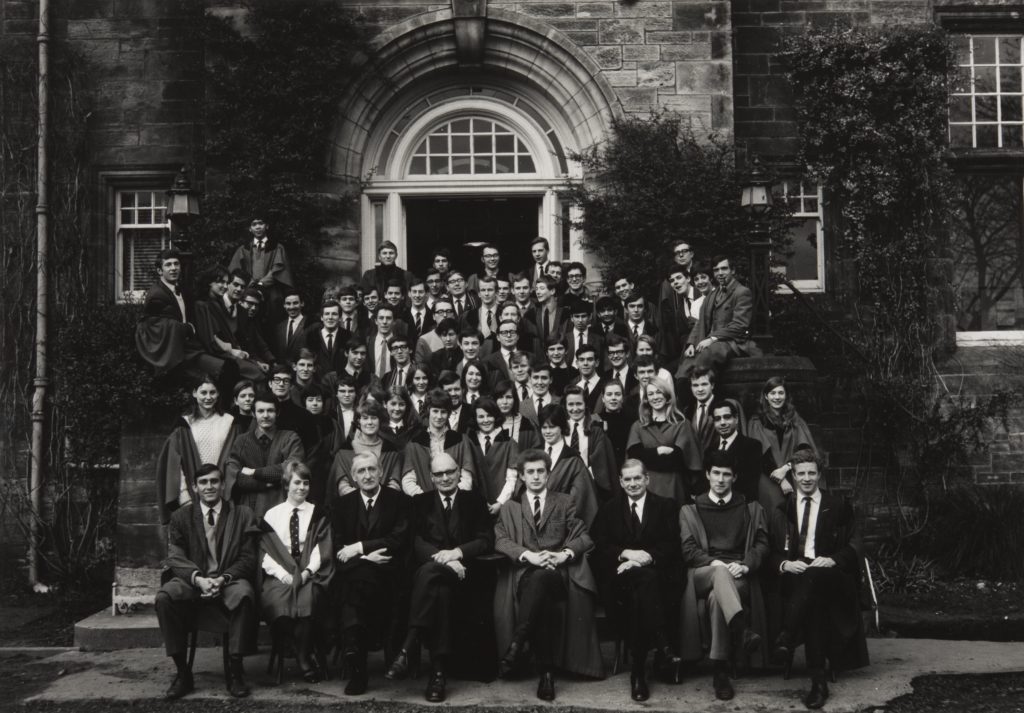
Physiology practicals were also popular. Although it is no longer permitted now, we were allowed to experiment on each other. Amongst other practicals, we passed nasogastric tubes down each other’s oesophagus to measure the acidity of gastric secretions, and inflicted insulin-induced hypoglycaemia on each other (measured by amateurish thumb pinprick capillary samples on the vasoconstricted digits of our increasingly agitated subjects).
During our time at university, particularly the years 1966-69, we witnessed a period of great change in politics and society in both the UK and the world. Politically, it seemed as if St Andrews was the only UK university to remain right-wing. The University was dominated by its Conservative Association, which counted among its ranks the emerging leaders of the Adam Smith Institute. They would go on to influence the Thatcherite revolution of the 1980s. In 1967, when Ian Smith declared unilateral independence for Rhodesia to preserve white rule, the Association celebrated by burning an effigy of Harold Wilson (the Labour Prime Minister) on West Sands.
This Conservative dominance in St Andrews contrasted sharply with Dundee University, which separated from the University of St Andrews in 1967. Dundee had long been a radical city – evicting Winston Churchill as an MP in 1922 to replace him with a prohibitionist (Edwin Scrymgeour). By the 1960s, Dundee had had Labour MPs solidly for over two decades. Dundee’s student politics were mostly socialist.
The emerging youth culture of the late 1960s included fashion, oral contraceptives, and of course the world’s greatest modern music from the UK and USA. Saturday Hops in the Younger Hall featured Motown numbers while Ravi Shankar performed in Upper College Hall, and when Pink Floyd played in the Younger Hall their audience was deafened for days afterwards. Some of us hitchhiked to the Isle of Wight Festival. Our class member Paul Riley hitchhiked in summer armed with his kilt and his accordion to make much money in France.
When it came to fashion, female students raised their gowns to show off their miniskirts (and their blue legs on the chilly streets of St Andrews) although their miniskirts were replaced by maxiskirts as fashion changed again towards the 1970s. By the time we left St Andrews in 1969 for clinical training in Dundee and summer clinical clerkships worldwide, the traditional ranking of bejantines, semis, tertians and magistrands had been overturned: the youngsters were now the trendies.
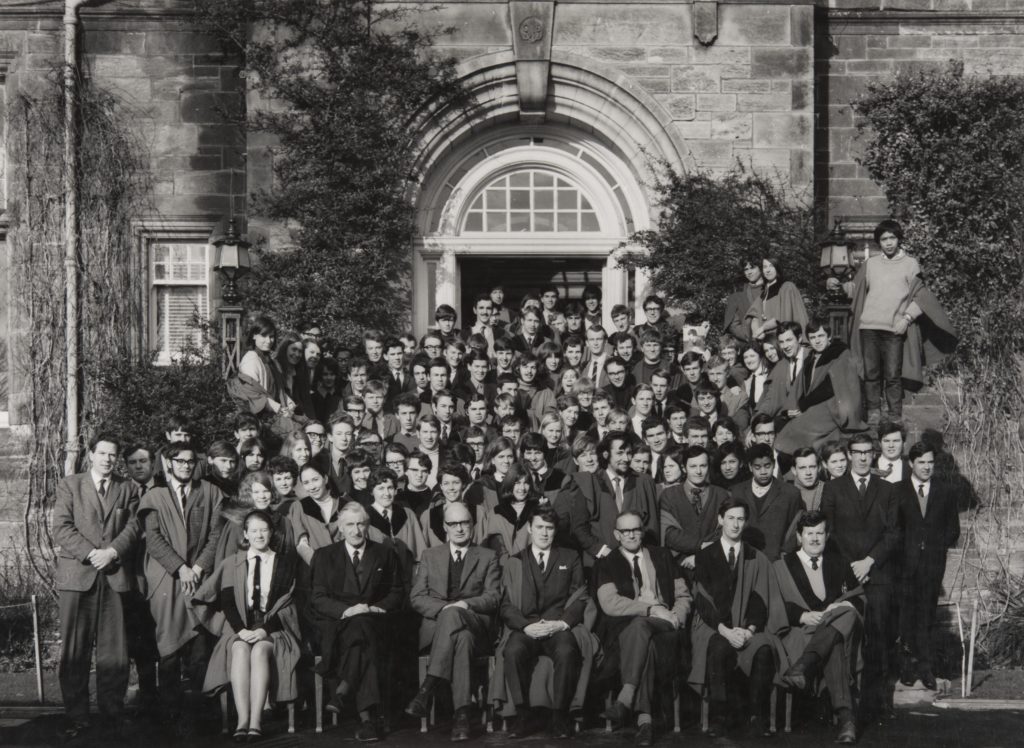
Three key anniversaries
We graduated in 1972 with the choice of the last St Andrews MB ChB graduation – or the first Dundee MB ChB graduation. This year marks the 50th anniversary of these graduations as well as the 125th anniversary of the 1897 founding of the Conjoint Medical School of University College Dundee and the University of St Andrews.
Happily, this year will also see the first graduation of the four-year Scottish Graduate Entry Medicine (ScotGEM) medical programme run by both medical schools – the first medical graduation since our own in 1972. The programme is tailored to meet the current and future needs of the NHS in Scotland and focuses on rural medicine and healthcare improvement. Happy but surprising news for those of us who thought our graduation would be the last!
50th Anniversary celebrations
Perhaps unsurprisingly with so much to celebrate, our 50th anniversary celebrations were many and enthusiastic. They started early on 19 May with a gin reception, which saw the distribution of our 50th anniversary souvenir yearbook and an audio-visual display of pictures and songs over our 50 years – both organised by 1972 club members Colin Orchard and Colin Hughson.
Celebrations fully kickstarted on 20 May, however, with visits to the Dundee Medical School at Ninewells Hospital and to the Tayside Medical Museum. Here, we saw exhibits from Dundee Royal Infirmary where most of our clinical teaching occurred, as well as a nostalgic display of University of Dundee photographs and publications from our student years.
It was during a coffee break at the Tayside Medical Museum that we had the opportunity to meet the first two University of St Andrews Wardlaw medical scholars, whom our class has supported over the last four years.
Twenty Dundee Class members and partners visited the Victoria and Albert Museum and had a lunch and a tour.
Our St Andrews class members and their partners went instead to see the new University of St Andrews School of Medicine, where we toured the Clinical Skills Centre and learned about the School’s research programme.
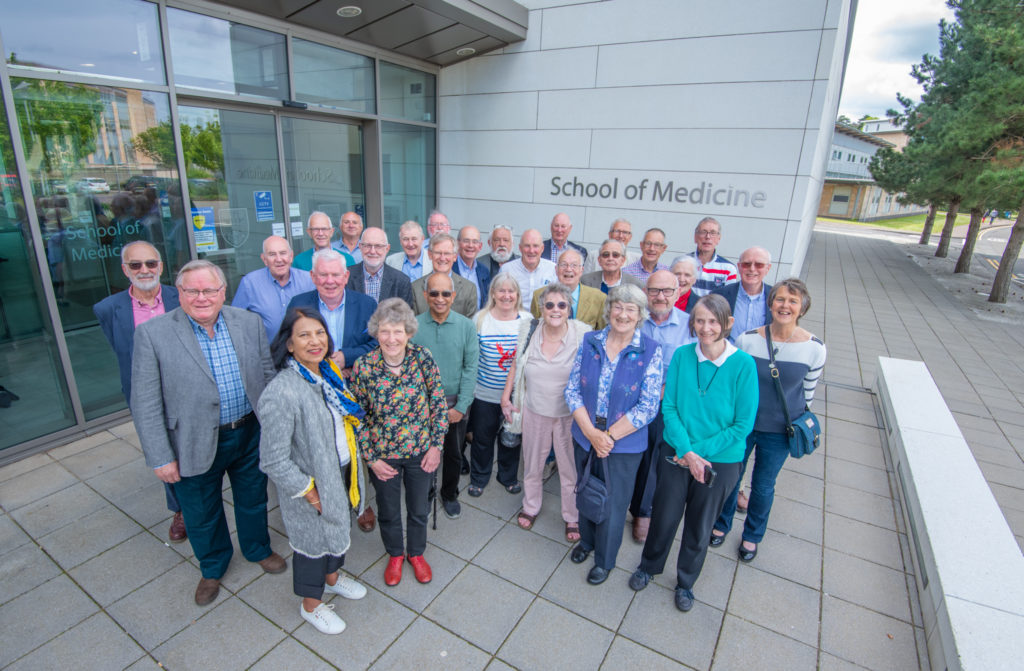
Photo credit: Gayle Macintyre
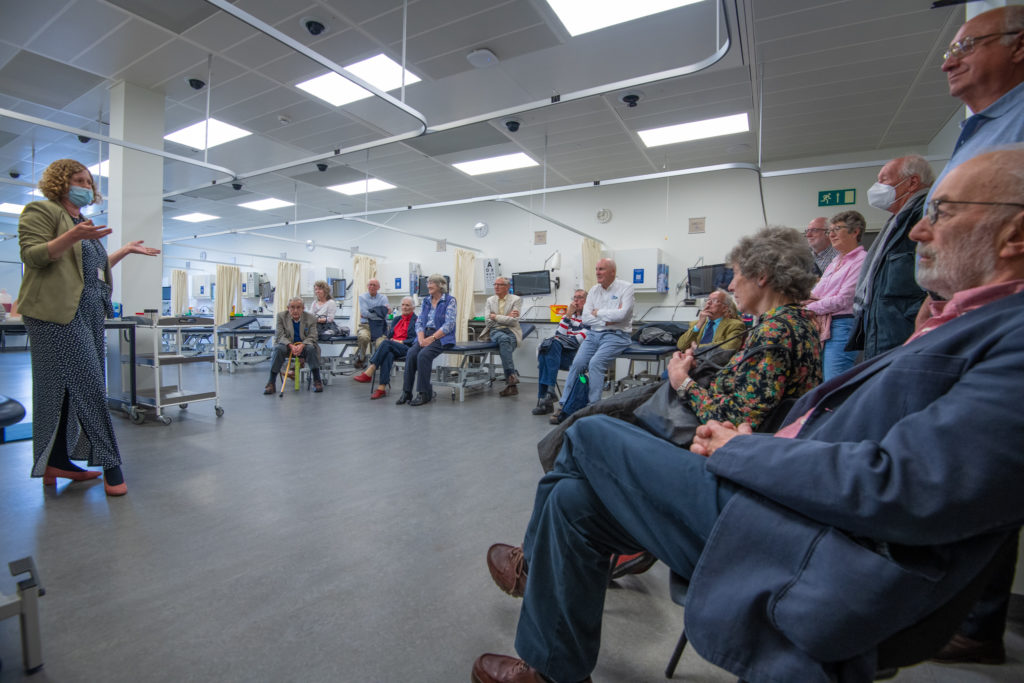

Our next port of call was what used to be the Anatomy lecture theatre in the old Bute Medical School building – the scene of David Sinclair’s inaugural speech and many other nostalgic memories!
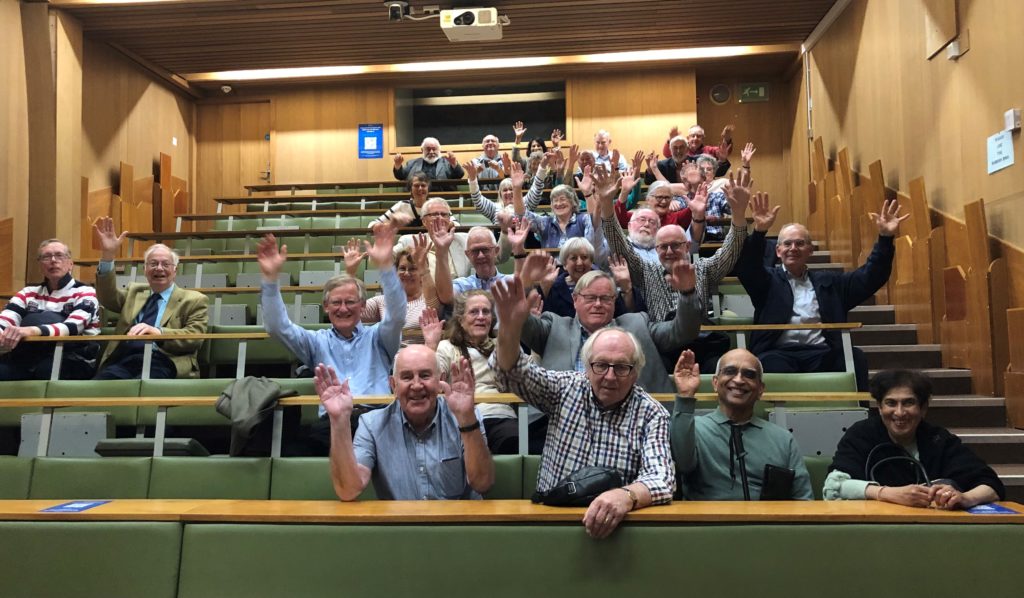
We also toured the Bell-Pettigrew Zoology Museum and the new Laidlaw Music School before returning to the Landmark Hotel to celebrate in earnest.

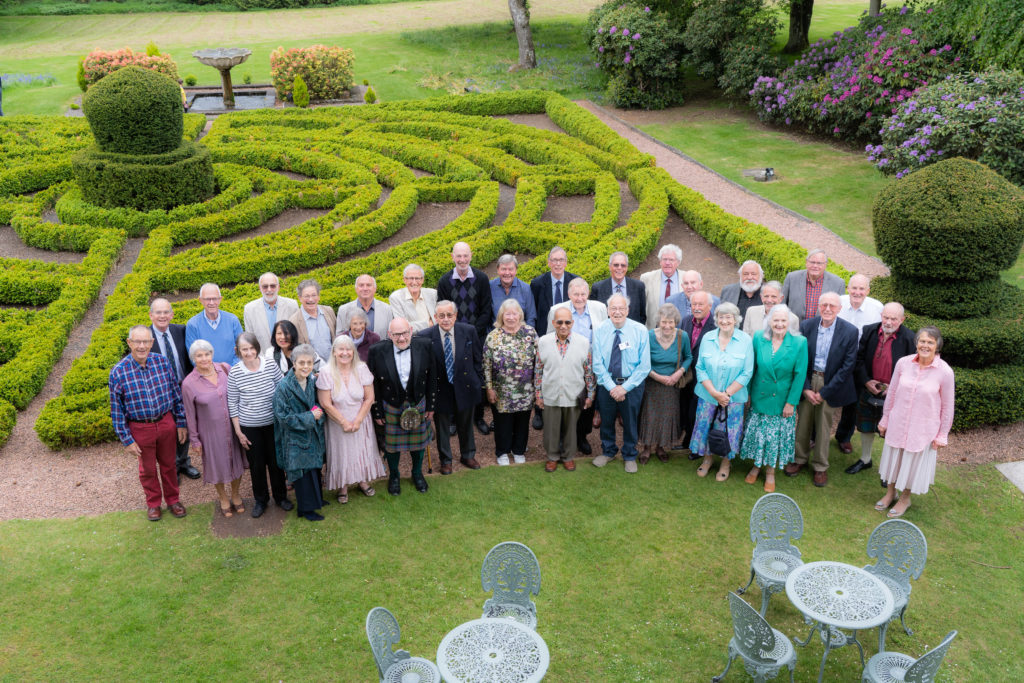
It was at the hotel that we presented copies of our souvenir yearbook to the Principal and Vice-Chancellor of the University of St Andrews, Professor Dame Sally Mapstone, in the presence of the current Dean of Medicine at St Andrews, Professor David Crossman, and to Professor Rory McCrimmon, Dean of the School of Medicine of the University of Dundee.

Principal Sally Mapstone then cut the 50th anniversary reunion cake decorated with the crests of both universities, and the Deans reviewed current developments at their respective medical schools. We all raised a glass of champagne to their success.
After dinner, our celebrations became more musical in nature. We enjoyed the music of the “Crusty Ceilidh Band” (comprising Ian Clark, Ian Lightbody, Jane Macintyre, John MacRae, Paul Riley, Stuart Anderson, Julian Newton, Malcolm Binns and Gordon Lowe). They performed five Scottish songs and, once we were given kazoos and copies of the lyrics, we all joined in enthusiastically.
Angus Wallace, Willy Weir and Dave Layfield – members of our rugby club (the Elephants) – then serenaded us, while Jill Grey reprised two self-composed songs on medical subjects that she originally performed in 1972 at our Medics Revue.
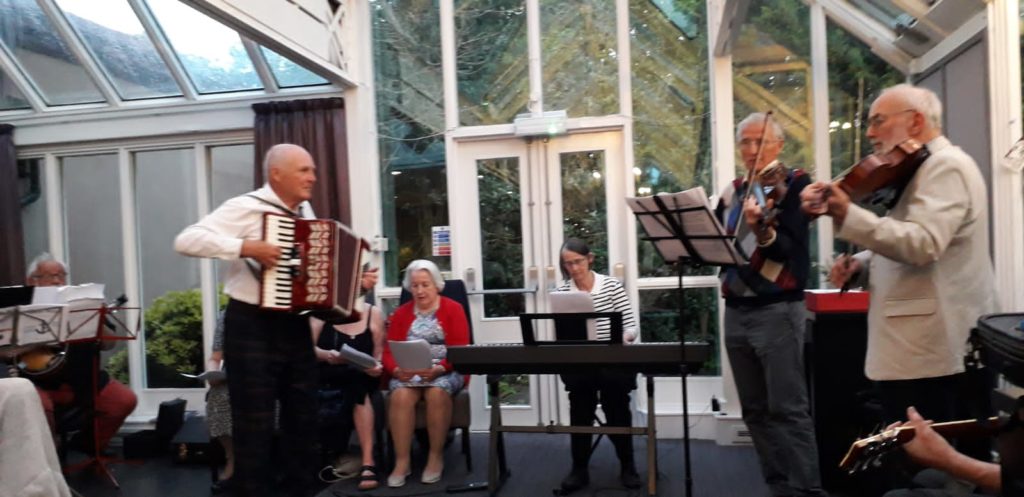
This 50th reunion was a very special one in many ways – not only because it gave us the opportunity to share so many wonderful memories, but also because it inspired us to give back by helping future generations of medics through our 1972 Medical Wardlaw Scholarships.
Advice from the Class of 1972 to the first ScotGEM graduates
“Maintain your independence and use your discretion to put patients’ interests first.”
(Professor Hugh MacDougall)
“Enjoy the world of medicine… rural communities are wonderful places to live in and there is so much you can do when you know the community well.”
(Dr Ian Clark)
“It is very important to learn how to listen and to hear … follow your dreams and if at first you don’t succeed, try and try again… and finally remember that “all glory comes from daring to begin”
(Dr Jill Grey)